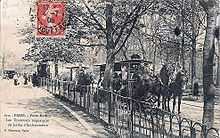Jardin d'Acclimatation railway

The Jardin d'Acclimatation railway is a 500 mm (19 3⁄4 in) minimum gauge park railway, located in the Bois de Boulogne in Paris. It was opened in 1878 and now connects Porte Maillot and the Jardin d'Acclimatation (zoological gardens), 800 meters apart. It was the first passenger-carrying narrow gauge railway of France.
History

The French narrow gauge railway pioneer Paul Deacauville wanted to experiment with passenger transport using his portable railways, already successfully introduced in the industry and agriculture. For the 1878 Exposition Universelle he proposed to use his concept for the exhibition by a line Trocadéro - Military Academy passing the Champ-de-Mars, but permission was denied. He then offered the same facility at the Zoological Gardens, which was accepted. Two kilometers of railway line at the track gauge of 500 mm (19 3⁄4 in) was constructed for the transportation of the exhibit visitors over a circular track, having a maximum speed of 15 km/h. The line carried up to 3000 passengers on some Sundays and received a very positive response from the visitors. But for some unknown reason, the network was quickly removed.
In 1880, a new modified line connected the garden to the Porte Maillot. It was constructed by another company and operated as a streetcar line with American vehicles hauled by ponies. These gave way to tractors in 1910. By 1930, the line was shortened at each end. Since then, it continues to link Porte Maillot to the garden, without being altered signifficantly since then.[1]
The line
The line originally featured a terminus loop at Porte Maillot, crossing the road at the Porte de Sablons, and follows a route through the woods to the garden, which is traversed for its entire length.[2] It was constructed in double track with each track following a slightly different alignment, with a total track length of five kilometers. Curves had a minimum radius of eight to fifteen meters .
In the early 1930s, the line was shortened at both ends. The section within the zoological garden was removed, and the road section to Porte Maillot, where an underground construction was created, required relocating of the terminal along the road at Porte des Sablons.[1]
Operations

Originally, two ponies towed the small vehicles alone or in groups of two. Each car had eight seats, with passengers sitting back to back on longitudinal seats. In 1910, animal traction gives way to steam outlined gasoline locomotives, equipped with a driver's cab at the rear of the engine. They hauled three to four cars equipped with crossbenches facing the direction of travel. The appearance of the locomotives has evolved over the years with one resembling Renault taxis, while another retained a more classic look .
In 1945, the shortage of gasoline caused the replacement of the gasoline locomotives with battery tractors, which probably came from the Universal Exhibition of 1937, with their wheels with tires running outside the rails. However, the gasoline locomotives were quickly returned to service. In 1960, Renault built seven tractors with two bogies. Their bodywork was steam outlined and brightly decorated. These machines measure 3.05 meters long and 1.20 meters wide, weigh five tons and reach 19 km / h with their engines of fifty-five horse-power. The trailers are those of the 1910s, the only modification being the addition of a small roof in the year 1951.[1] In 2010 new locomotives with electric traction came into service on the now 130-year-old railway.[3]
See also
| Wikimedia Commons has media related to Ligne du jardin d’acclimatation. |
References
- ↑ 1.0 1.1 1.2 Jean Robert, Les tramways parisiens, p. 498
- ↑ Satellite view Google maps
- ↑ L'histoire du Jardin - See the "En voiture!" section on the left pane